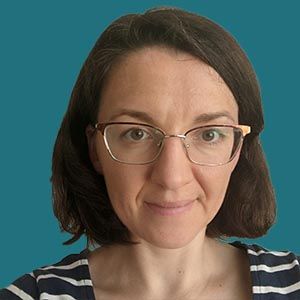Synthetic Promoters May Help Reduce Off-Target Expression in AAV Gene Therapy
Magdalena Cichewicz, PhD, a scientist II at Senti Biosciences, discussed preclinical research she presented at ASGCT’s 2023 conference.
Magdalena Cichewicz, PhD

Spark Therapeutics’ voretigene neparvovec (Luxturna), an adeno-associated virus (AAV) vector-based gene therapy indicated for the treatment of inherited retinal dystrophy related to mutations in the RPE65 gene, became the first gene therapy to have been approved by both the FDA and the European Medicines Agency for the treatment of a genetic disease in 2018.1,2 Since that time, interest in AAV vector-based gene therapies has increased, especially for ophthalmological indications, with more products being approved in subsequent years and many more clinical trials being initiated. Alongside this new activity, some companies and institutions have also begun researching ways to improve the safety of AAV vector-based gene therapies.
Notably, Magdalena Cichewicz, PhD, a scientist II at Senti Biosciences, and her colleagues from Senti and Spark Therapeutics, are currently conducting research aimed at identifying synthetic promoters for use in AAV vector-based gene therapies that could provide greater target-specificity.3 At the American Society of Gene and Cell Therapy (ASGCT) 2023 Annual Meeting, held May 16 to 20, in Los Angeles, California, Cichewicz spoke about preclinical findings in a presentation called “Massively parallel and systematic engineering platform for highly compact, cell-type specific, and potent smart sensor promoters for precision retinal gene therapies.”
Following the talk, CGTLive™ sat down with Cichewicz to discuss the data and their implications for the healthcare community. She noted that she and her colleagues discovered photoreceptor-specific synthetic promotors with 100 to 10,000-fold specificity for the on-target photoreceptor surrogate cell line Y79 over the off-target retinal pigment epithelium cell line ARPE-19.
CGTLive: Can you give some background information on the question or problem that your research is trying to address?
Magdalena Cichewicz, PhD: The main question of the project that we've been working on is to find a synthetic promoter, which may be useful for ocular-specific gene therapies. Currently, there are already successful ocular gene therapies, but there are always some challenges—for example, toxicity in off-target cell lines. In SentiBiosciences, we are focused on engineering and discovery of the synthetic short promoters, which will be very potent and very specific in the cell of interest. Here, we are very interested in photoreceptors.
Can you give an overview of the key results that you presented?
We were happy to discover very short synthetic promoters. All of the promoters in the project are below 500 base pairs, but we also have examples of promoters as short as 120 base pairs. We engineered sequences that are very potent. Some of them reach potency close to the CAG promoter, which is currently in use in gene therapies. At the same time, their specificity is very high—between 1000 to even more than 10,000-fold over our off-target surrogate cell line.
What would you say are the main implications that the healthcare community should take away from these findings?
Even though there are already gene therapies in use, there is still room for improvement because toxicity is always a challenge—there’s always the problem of additional responses from off-target sites, which are always present in the tissue, whether it’s the eye or any other tissue in the body or any other disease. We are convinced that our workflow is very potent and may be used in different tissues of interest in different diseases, so we are looking for additional collaborations—additional interest in this workflow.
Were there any challenges or limitations in this research? Or are there any areas of interest that you've identified for future research?
There was a very thoughtful comment after my talk. I was asked whether we worked with additional models or if we were focused only on the surrogate cell lines in vitro—immortalized cell lines. Of course, I feel the sequences that we discovered are very potent, but it was just the very first step of the collaboration of the whole project because now the sequences have to be tested in additional, closer-to-human models—even going into in vivo. I think moving from in vitro immortalized cell lines to other models, like induced pluripotent stem cell-derived cells or human-derived organoids—in general, this is something very exciting for me as a scientist.
Is there anything else that you’d like to share with the audience?
In general, in Senti Biosciences, we are a group of synthetic biologists. We thrive from working with natural-derived sequences—building them into synthetic sequences, which may be potent in specific diseases, in specific cells—and they meet specific requirements of interest, which may come from clinicians. We are happy to provide this help to the community.
Transcript edited for clarity.
Click here for more coverage of ASGCT 2023.
REFERENCES
1. FDA approves Spark Therapeutics’ LUXTURNA™ (voretigeneneparvovec-rzyl), a one-time gene therapy for patients with confirmed biallelic RPE65 mutation-associated retinal dystrophy. News release. Spark Therapeutics. December 19, 2017. Accessed April 26, 2023. https://sparktx.com/press_releases/fda-approves-spark-therapeutics-luxturna-voretigene-neparvovec-rzyl-a-one-time-gene-therapy-for-patients-with-confirmed-biallelic-rpe65-mutation-associated-retinal-dystrophy/
2. European Commission approves Spark Therapeutics’ LUXTURNA® (voretigeneneparvovec), a one-time gene therapy for inherited retinal disease caused by confirmed biallelic RPE65 mutations. News release. Spark Therapeutics. November 23, 2018. Accessed April 24, 2023. https://sparktx.com/press_releases/european-commission-approves-spark-therapeutics-luxturna-voretigene-neparvovec-a-one-time-gene-therapy-for-inherited-retinal-disease-caused-by-confirmed-biallelic-rpe65-mutations/
3. Draut J, Zaw T, MacEachern M, et al. Massively parallel and systematic engineering platform for highly compact, cell-type specific, and potent smart sensor promoters for precision retinal gene therapies. Presented at: American Society of Gene and Cell Therapy (ASGCT) 2023 Annual Meeting. May 16-20, 2023; Los Angeles, CA. Abstract #341
Considerations for Administering Hemoglobinopathy Gene Therapies From a Pharmacist’s Perspective
April 20th 2024Alexis Kuhn, PharmD, BCOP, a pediatric oncology pharmacist at Mayo Clinic, discussed the incorporation of the recently FDA-approved gene therapies for SCD and TDT into the work of pharmacists.